Management
VerifiedAdded on 2023/01/23
|7
|1626
|90
AI Summary
This document discusses the functions of management, including staff controlling, inventory control, revenue control, and leading. It also explores the differences between a leader and a manager. The challenges faced in the controlling function are also highlighted.
Contribute Materials
Your contribution can guide someone’s learning journey. Share your
documents today.
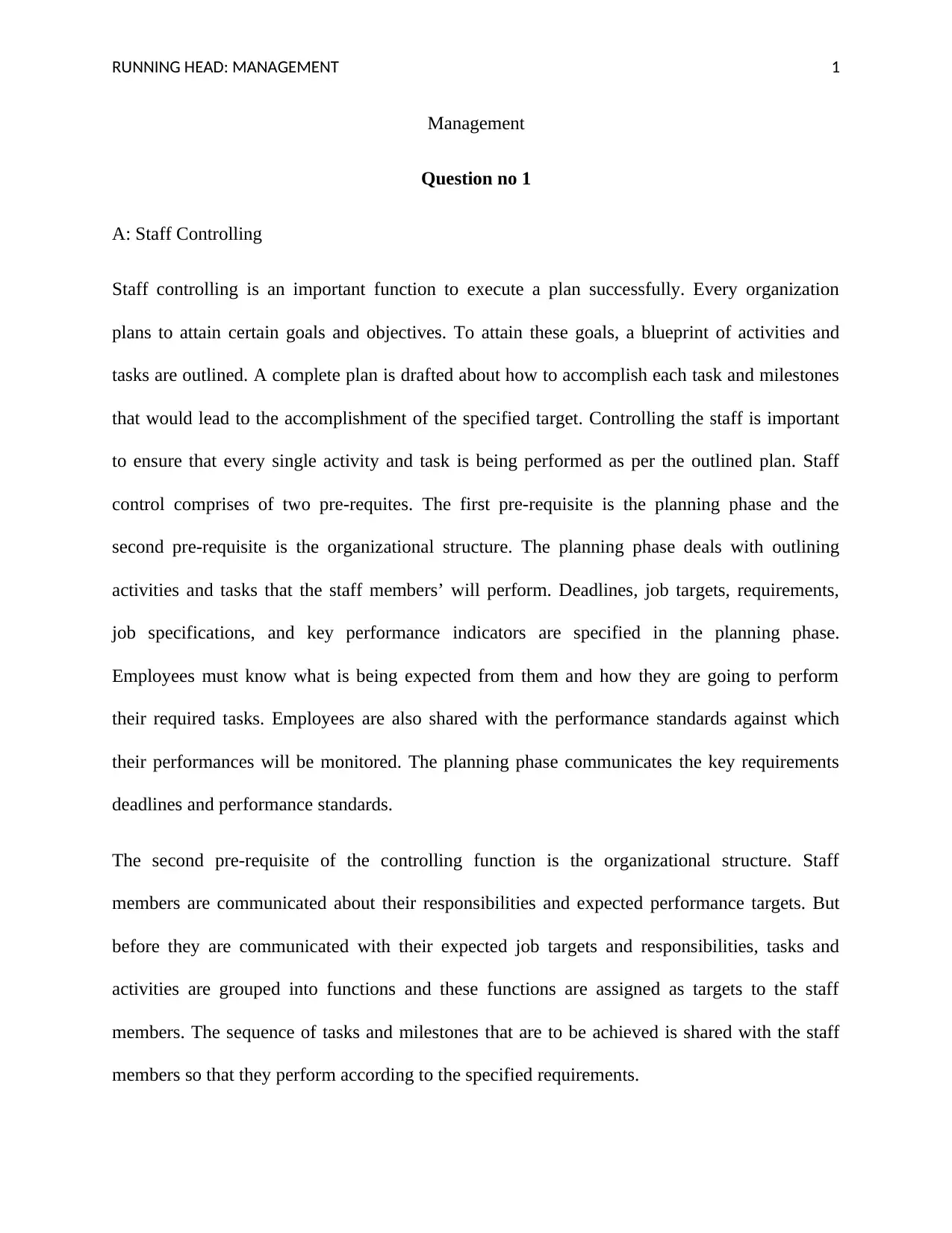
RUNNING HEAD: MANAGEMENT 1
Management
Question no 1
A: Staff Controlling
Staff controlling is an important function to execute a plan successfully. Every organization
plans to attain certain goals and objectives. To attain these goals, a blueprint of activities and
tasks are outlined. A complete plan is drafted about how to accomplish each task and milestones
that would lead to the accomplishment of the specified target. Controlling the staff is important
to ensure that every single activity and task is being performed as per the outlined plan. Staff
control comprises of two pre-requites. The first pre-requisite is the planning phase and the
second pre-requisite is the organizational structure. The planning phase deals with outlining
activities and tasks that the staff members’ will perform. Deadlines, job targets, requirements,
job specifications, and key performance indicators are specified in the planning phase.
Employees must know what is being expected from them and how they are going to perform
their required tasks. Employees are also shared with the performance standards against which
their performances will be monitored. The planning phase communicates the key requirements
deadlines and performance standards.
The second pre-requisite of the controlling function is the organizational structure. Staff
members are communicated about their responsibilities and expected performance targets. But
before they are communicated with their expected job targets and responsibilities, tasks and
activities are grouped into functions and these functions are assigned as targets to the staff
members. The sequence of tasks and milestones that are to be achieved is shared with the staff
members so that they perform according to the specified requirements.
Management
Question no 1
A: Staff Controlling
Staff controlling is an important function to execute a plan successfully. Every organization
plans to attain certain goals and objectives. To attain these goals, a blueprint of activities and
tasks are outlined. A complete plan is drafted about how to accomplish each task and milestones
that would lead to the accomplishment of the specified target. Controlling the staff is important
to ensure that every single activity and task is being performed as per the outlined plan. Staff
control comprises of two pre-requites. The first pre-requisite is the planning phase and the
second pre-requisite is the organizational structure. The planning phase deals with outlining
activities and tasks that the staff members’ will perform. Deadlines, job targets, requirements,
job specifications, and key performance indicators are specified in the planning phase.
Employees must know what is being expected from them and how they are going to perform
their required tasks. Employees are also shared with the performance standards against which
their performances will be monitored. The planning phase communicates the key requirements
deadlines and performance standards.
The second pre-requisite of the controlling function is the organizational structure. Staff
members are communicated about their responsibilities and expected performance targets. But
before they are communicated with their expected job targets and responsibilities, tasks and
activities are grouped into functions and these functions are assigned as targets to the staff
members. The sequence of tasks and milestones that are to be achieved is shared with the staff
members so that they perform according to the specified requirements.
Secure Best Marks with AI Grader
Need help grading? Try our AI Grader for instant feedback on your assignments.
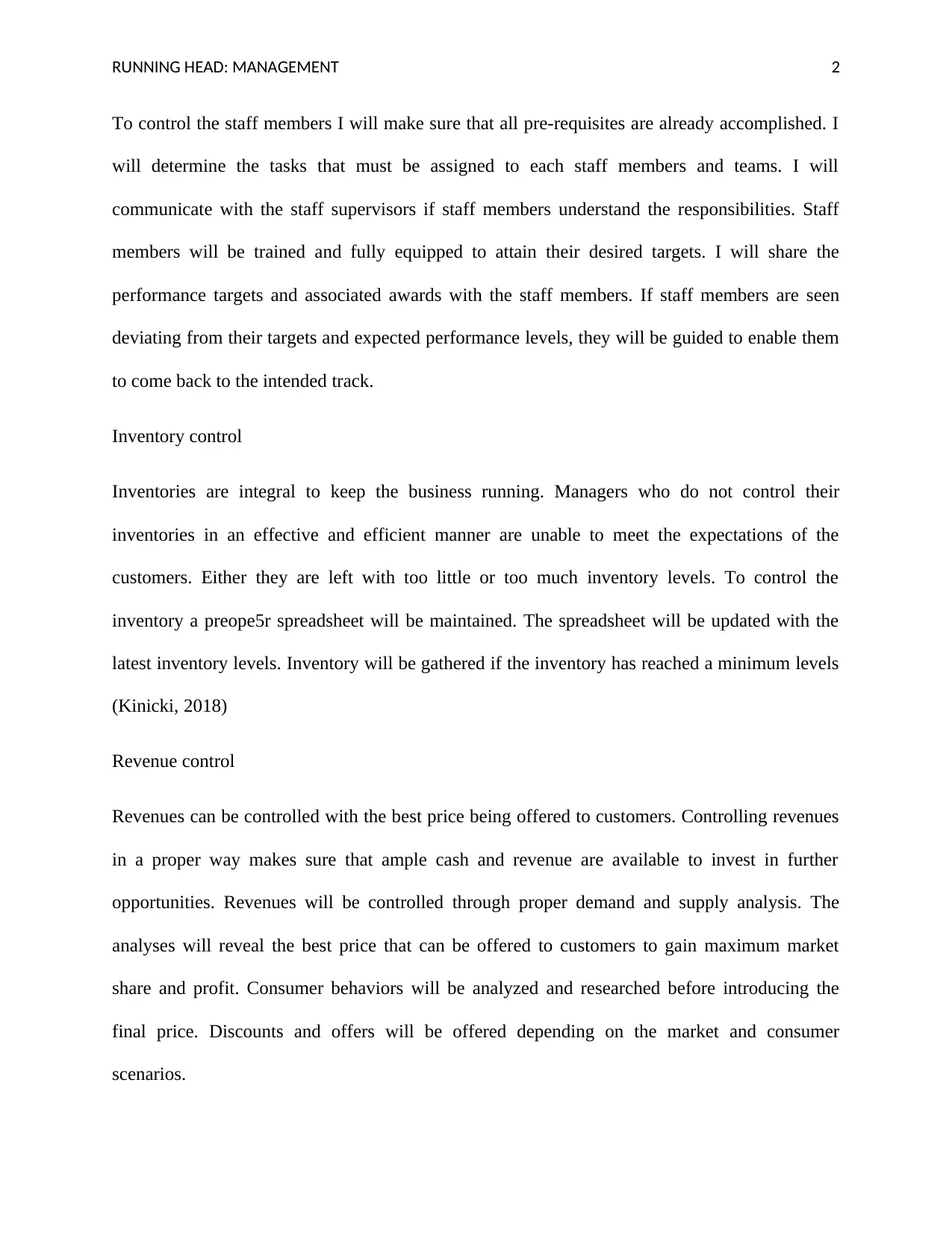
RUNNING HEAD: MANAGEMENT 2
To control the staff members I will make sure that all pre-requisites are already accomplished. I
will determine the tasks that must be assigned to each staff members and teams. I will
communicate with the staff supervisors if staff members understand the responsibilities. Staff
members will be trained and fully equipped to attain their desired targets. I will share the
performance targets and associated awards with the staff members. If staff members are seen
deviating from their targets and expected performance levels, they will be guided to enable them
to come back to the intended track.
Inventory control
Inventories are integral to keep the business running. Managers who do not control their
inventories in an effective and efficient manner are unable to meet the expectations of the
customers. Either they are left with too little or too much inventory levels. To control the
inventory a preope5r spreadsheet will be maintained. The spreadsheet will be updated with the
latest inventory levels. Inventory will be gathered if the inventory has reached a minimum levels
(Kinicki, 2018)
Revenue control
Revenues can be controlled with the best price being offered to customers. Controlling revenues
in a proper way makes sure that ample cash and revenue are available to invest in further
opportunities. Revenues will be controlled through proper demand and supply analysis. The
analyses will reveal the best price that can be offered to customers to gain maximum market
share and profit. Consumer behaviors will be analyzed and researched before introducing the
final price. Discounts and offers will be offered depending on the market and consumer
scenarios.
To control the staff members I will make sure that all pre-requisites are already accomplished. I
will determine the tasks that must be assigned to each staff members and teams. I will
communicate with the staff supervisors if staff members understand the responsibilities. Staff
members will be trained and fully equipped to attain their desired targets. I will share the
performance targets and associated awards with the staff members. If staff members are seen
deviating from their targets and expected performance levels, they will be guided to enable them
to come back to the intended track.
Inventory control
Inventories are integral to keep the business running. Managers who do not control their
inventories in an effective and efficient manner are unable to meet the expectations of the
customers. Either they are left with too little or too much inventory levels. To control the
inventory a preope5r spreadsheet will be maintained. The spreadsheet will be updated with the
latest inventory levels. Inventory will be gathered if the inventory has reached a minimum levels
(Kinicki, 2018)
Revenue control
Revenues can be controlled with the best price being offered to customers. Controlling revenues
in a proper way makes sure that ample cash and revenue are available to invest in further
opportunities. Revenues will be controlled through proper demand and supply analysis. The
analyses will reveal the best price that can be offered to customers to gain maximum market
share and profit. Consumer behaviors will be analyzed and researched before introducing the
final price. Discounts and offers will be offered depending on the market and consumer
scenarios.
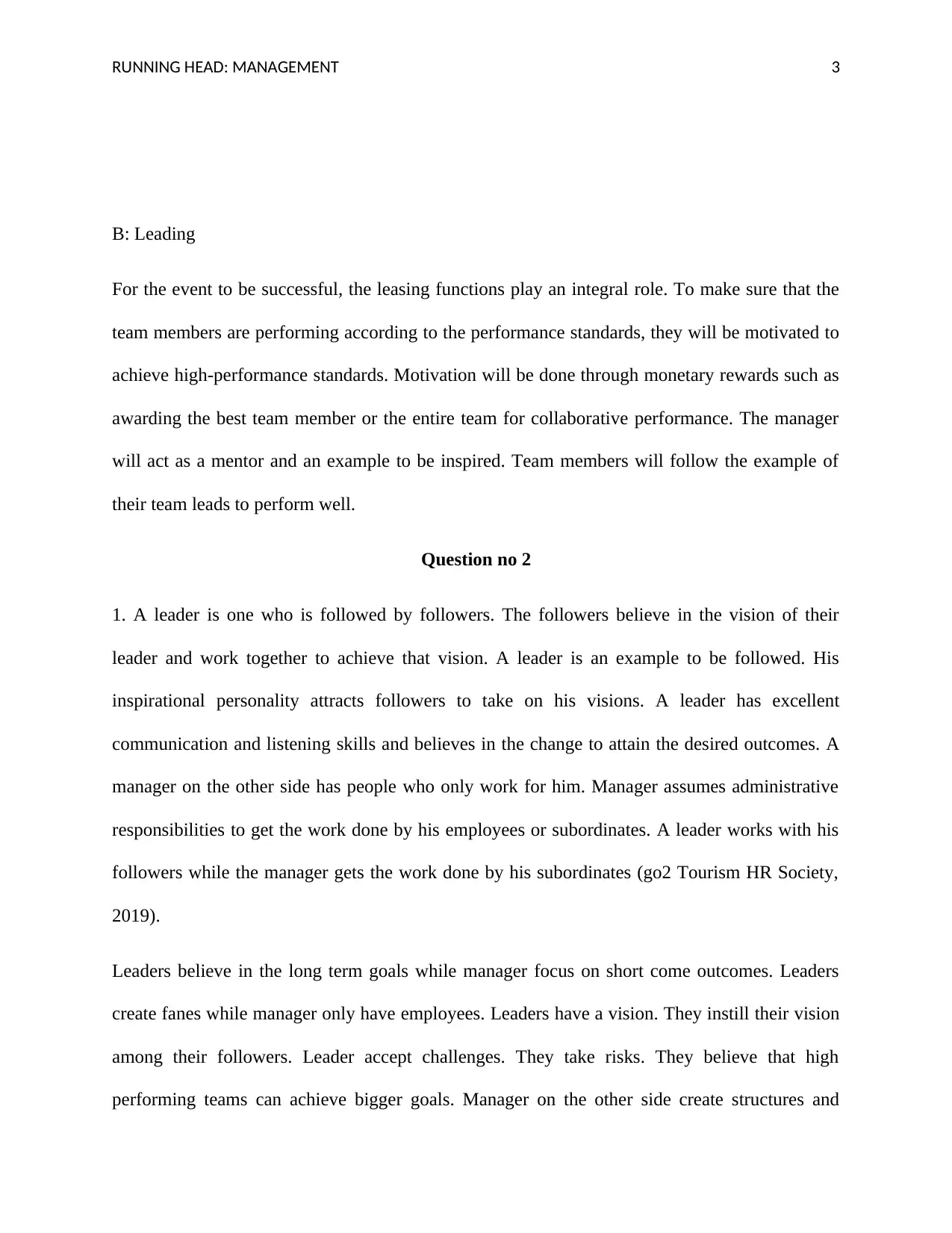
RUNNING HEAD: MANAGEMENT 3
B: Leading
For the event to be successful, the leasing functions play an integral role. To make sure that the
team members are performing according to the performance standards, they will be motivated to
achieve high-performance standards. Motivation will be done through monetary rewards such as
awarding the best team member or the entire team for collaborative performance. The manager
will act as a mentor and an example to be inspired. Team members will follow the example of
their team leads to perform well.
Question no 2
1. A leader is one who is followed by followers. The followers believe in the vision of their
leader and work together to achieve that vision. A leader is an example to be followed. His
inspirational personality attracts followers to take on his visions. A leader has excellent
communication and listening skills and believes in the change to attain the desired outcomes. A
manager on the other side has people who only work for him. Manager assumes administrative
responsibilities to get the work done by his employees or subordinates. A leader works with his
followers while the manager gets the work done by his subordinates (go2 Tourism HR Society,
2019).
Leaders believe in the long term goals while manager focus on short come outcomes. Leaders
create fanes while manager only have employees. Leaders have a vision. They instill their vision
among their followers. Leader accept challenges. They take risks. They believe that high
performing teams can achieve bigger goals. Manager on the other side create structures and
B: Leading
For the event to be successful, the leasing functions play an integral role. To make sure that the
team members are performing according to the performance standards, they will be motivated to
achieve high-performance standards. Motivation will be done through monetary rewards such as
awarding the best team member or the entire team for collaborative performance. The manager
will act as a mentor and an example to be inspired. Team members will follow the example of
their team leads to perform well.
Question no 2
1. A leader is one who is followed by followers. The followers believe in the vision of their
leader and work together to achieve that vision. A leader is an example to be followed. His
inspirational personality attracts followers to take on his visions. A leader has excellent
communication and listening skills and believes in the change to attain the desired outcomes. A
manager on the other side has people who only work for him. Manager assumes administrative
responsibilities to get the work done by his employees or subordinates. A leader works with his
followers while the manager gets the work done by his subordinates (go2 Tourism HR Society,
2019).
Leaders believe in the long term goals while manager focus on short come outcomes. Leaders
create fanes while manager only have employees. Leaders have a vision. They instill their vision
among their followers. Leader accept challenges. They take risks. They believe that high
performing teams can achieve bigger goals. Manager on the other side create structures and
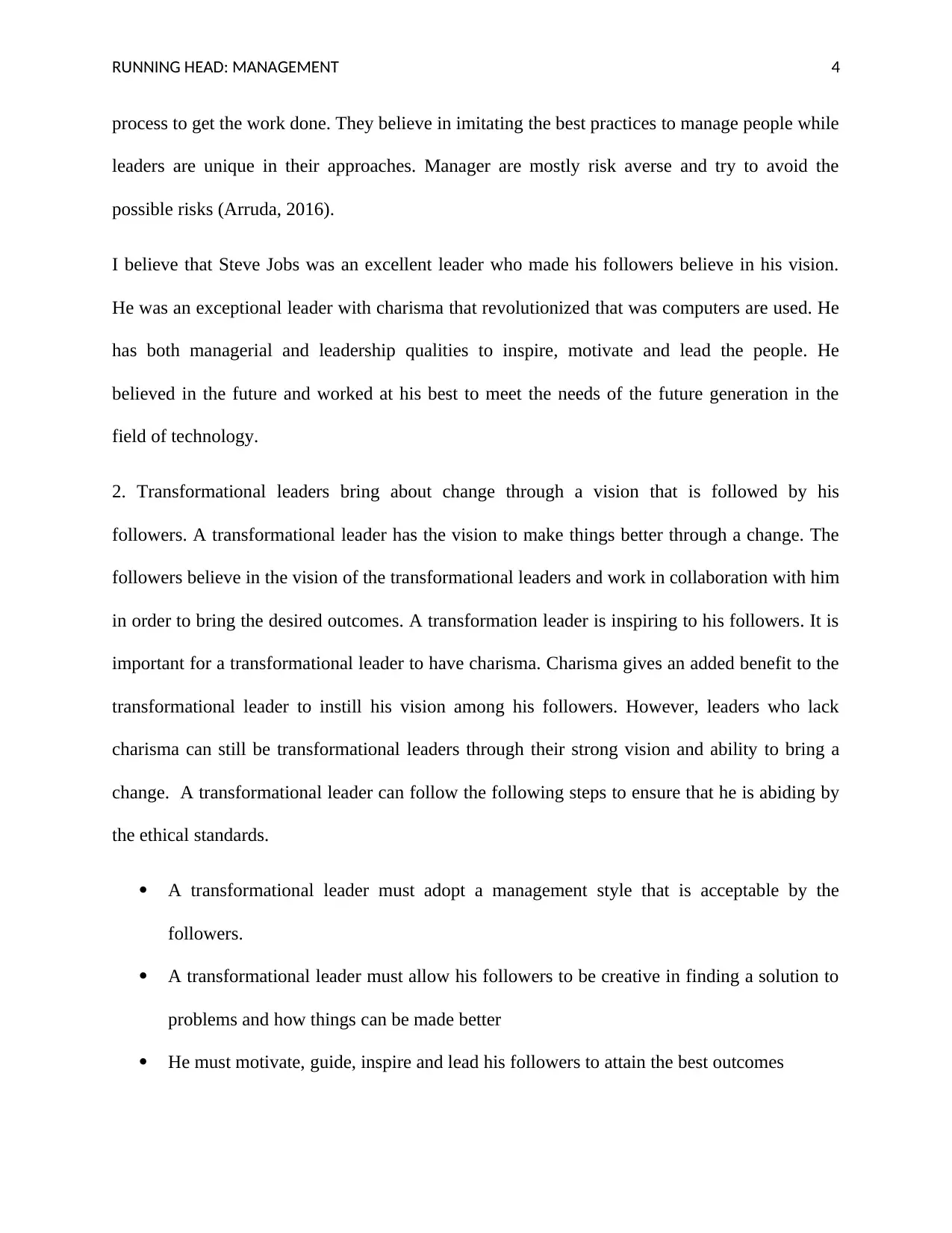
RUNNING HEAD: MANAGEMENT 4
process to get the work done. They believe in imitating the best practices to manage people while
leaders are unique in their approaches. Manager are mostly risk averse and try to avoid the
possible risks (Arruda, 2016).
I believe that Steve Jobs was an excellent leader who made his followers believe in his vision.
He was an exceptional leader with charisma that revolutionized that was computers are used. He
has both managerial and leadership qualities to inspire, motivate and lead the people. He
believed in the future and worked at his best to meet the needs of the future generation in the
field of technology.
2. Transformational leaders bring about change through a vision that is followed by his
followers. A transformational leader has the vision to make things better through a change. The
followers believe in the vision of the transformational leaders and work in collaboration with him
in order to bring the desired outcomes. A transformation leader is inspiring to his followers. It is
important for a transformational leader to have charisma. Charisma gives an added benefit to the
transformational leader to instill his vision among his followers. However, leaders who lack
charisma can still be transformational leaders through their strong vision and ability to bring a
change. A transformational leader can follow the following steps to ensure that he is abiding by
the ethical standards.
A transformational leader must adopt a management style that is acceptable by the
followers.
A transformational leader must allow his followers to be creative in finding a solution to
problems and how things can be made better
He must motivate, guide, inspire and lead his followers to attain the best outcomes
process to get the work done. They believe in imitating the best practices to manage people while
leaders are unique in their approaches. Manager are mostly risk averse and try to avoid the
possible risks (Arruda, 2016).
I believe that Steve Jobs was an excellent leader who made his followers believe in his vision.
He was an exceptional leader with charisma that revolutionized that was computers are used. He
has both managerial and leadership qualities to inspire, motivate and lead the people. He
believed in the future and worked at his best to meet the needs of the future generation in the
field of technology.
2. Transformational leaders bring about change through a vision that is followed by his
followers. A transformational leader has the vision to make things better through a change. The
followers believe in the vision of the transformational leaders and work in collaboration with him
in order to bring the desired outcomes. A transformation leader is inspiring to his followers. It is
important for a transformational leader to have charisma. Charisma gives an added benefit to the
transformational leader to instill his vision among his followers. However, leaders who lack
charisma can still be transformational leaders through their strong vision and ability to bring a
change. A transformational leader can follow the following steps to ensure that he is abiding by
the ethical standards.
A transformational leader must adopt a management style that is acceptable by the
followers.
A transformational leader must allow his followers to be creative in finding a solution to
problems and how things can be made better
He must motivate, guide, inspire and lead his followers to attain the best outcomes
Secure Best Marks with AI Grader
Need help grading? Try our AI Grader for instant feedback on your assignments.
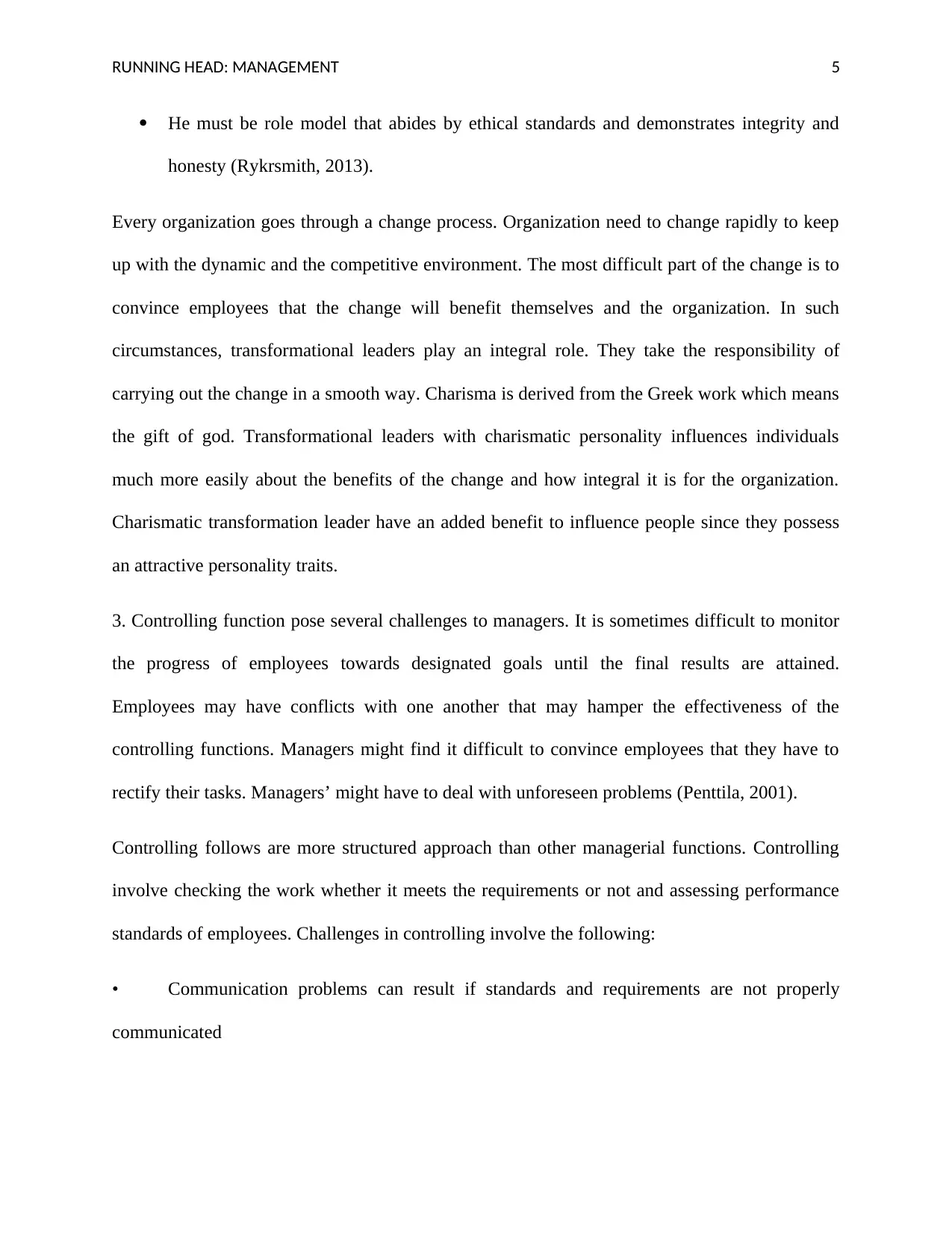
RUNNING HEAD: MANAGEMENT 5
He must be role model that abides by ethical standards and demonstrates integrity and
honesty (Rykrsmith, 2013).
Every organization goes through a change process. Organization need to change rapidly to keep
up with the dynamic and the competitive environment. The most difficult part of the change is to
convince employees that the change will benefit themselves and the organization. In such
circumstances, transformational leaders play an integral role. They take the responsibility of
carrying out the change in a smooth way. Charisma is derived from the Greek work which means
the gift of god. Transformational leaders with charismatic personality influences individuals
much more easily about the benefits of the change and how integral it is for the organization.
Charismatic transformation leader have an added benefit to influence people since they possess
an attractive personality traits.
3. Controlling function pose several challenges to managers. It is sometimes difficult to monitor
the progress of employees towards designated goals until the final results are attained.
Employees may have conflicts with one another that may hamper the effectiveness of the
controlling functions. Managers might find it difficult to convince employees that they have to
rectify their tasks. Managers’ might have to deal with unforeseen problems (Penttila, 2001).
Controlling follows are more structured approach than other managerial functions. Controlling
involve checking the work whether it meets the requirements or not and assessing performance
standards of employees. Challenges in controlling involve the following:
• Communication problems can result if standards and requirements are not properly
communicated
He must be role model that abides by ethical standards and demonstrates integrity and
honesty (Rykrsmith, 2013).
Every organization goes through a change process. Organization need to change rapidly to keep
up with the dynamic and the competitive environment. The most difficult part of the change is to
convince employees that the change will benefit themselves and the organization. In such
circumstances, transformational leaders play an integral role. They take the responsibility of
carrying out the change in a smooth way. Charisma is derived from the Greek work which means
the gift of god. Transformational leaders with charismatic personality influences individuals
much more easily about the benefits of the change and how integral it is for the organization.
Charismatic transformation leader have an added benefit to influence people since they possess
an attractive personality traits.
3. Controlling function pose several challenges to managers. It is sometimes difficult to monitor
the progress of employees towards designated goals until the final results are attained.
Employees may have conflicts with one another that may hamper the effectiveness of the
controlling functions. Managers might find it difficult to convince employees that they have to
rectify their tasks. Managers’ might have to deal with unforeseen problems (Penttila, 2001).
Controlling follows are more structured approach than other managerial functions. Controlling
involve checking the work whether it meets the requirements or not and assessing performance
standards of employees. Challenges in controlling involve the following:
• Communication problems can result if standards and requirements are not properly
communicated
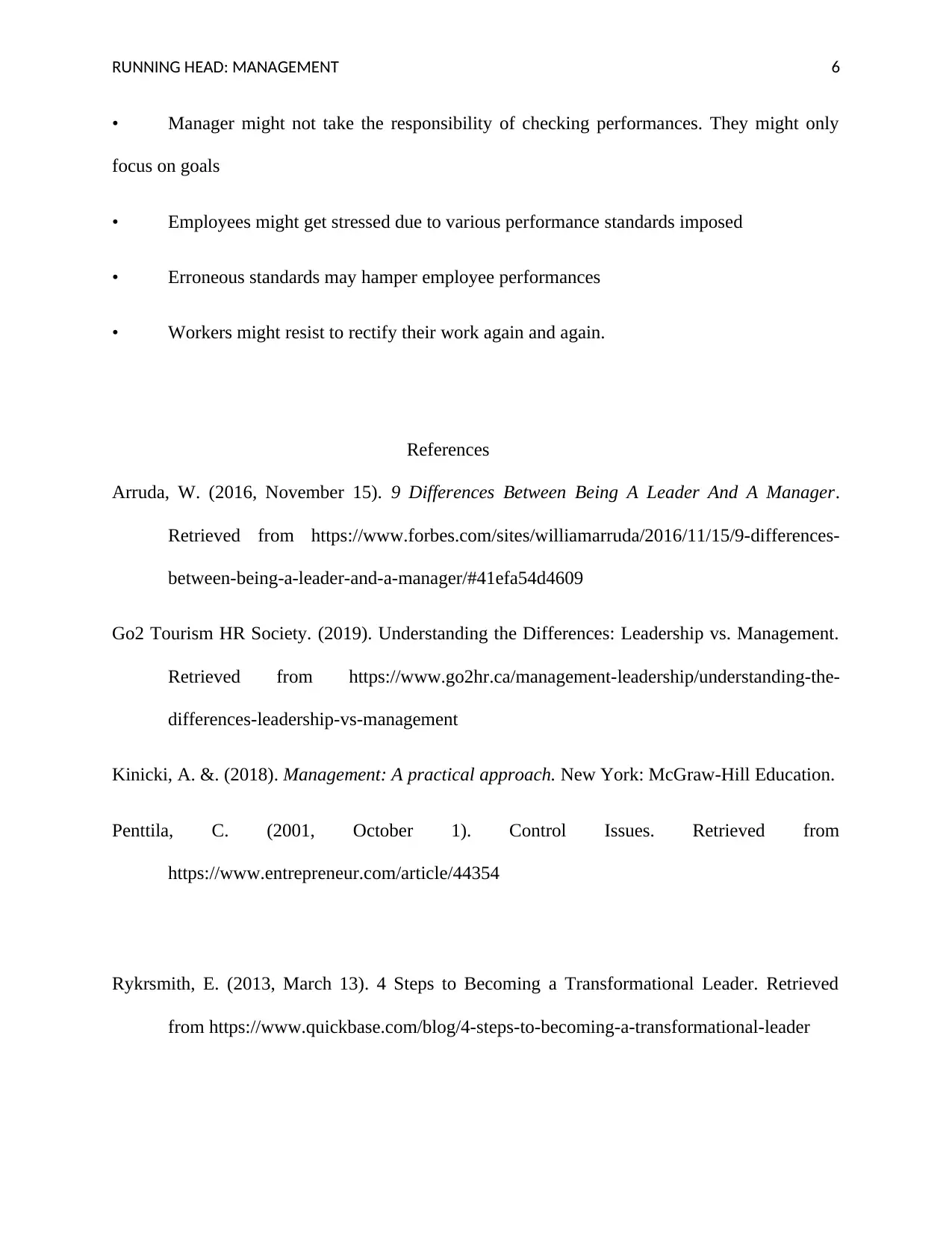
RUNNING HEAD: MANAGEMENT 6
• Manager might not take the responsibility of checking performances. They might only
focus on goals
• Employees might get stressed due to various performance standards imposed
• Erroneous standards may hamper employee performances
• Workers might resist to rectify their work again and again.
References
Arruda, W. (2016, November 15). 9 Differences Between Being A Leader And A Manager.
Retrieved from https://www.forbes.com/sites/williamarruda/2016/11/15/9-differences-
between-being-a-leader-and-a-manager/#41efa54d4609
Go2 Tourism HR Society. (2019). Understanding the Differences: Leadership vs. Management.
Retrieved from https://www.go2hr.ca/management-leadership/understanding-the-
differences-leadership-vs-management
Kinicki, A. &. (2018). Management: A practical approach. New York: McGraw-Hill Education.
Penttila, C. (2001, October 1). Control Issues. Retrieved from
https://www.entrepreneur.com/article/44354
Rykrsmith, E. (2013, March 13). 4 Steps to Becoming a Transformational Leader. Retrieved
from https://www.quickbase.com/blog/4-steps-to-becoming-a-transformational-leader
• Manager might not take the responsibility of checking performances. They might only
focus on goals
• Employees might get stressed due to various performance standards imposed
• Erroneous standards may hamper employee performances
• Workers might resist to rectify their work again and again.
References
Arruda, W. (2016, November 15). 9 Differences Between Being A Leader And A Manager.
Retrieved from https://www.forbes.com/sites/williamarruda/2016/11/15/9-differences-
between-being-a-leader-and-a-manager/#41efa54d4609
Go2 Tourism HR Society. (2019). Understanding the Differences: Leadership vs. Management.
Retrieved from https://www.go2hr.ca/management-leadership/understanding-the-
differences-leadership-vs-management
Kinicki, A. &. (2018). Management: A practical approach. New York: McGraw-Hill Education.
Penttila, C. (2001, October 1). Control Issues. Retrieved from
https://www.entrepreneur.com/article/44354
Rykrsmith, E. (2013, March 13). 4 Steps to Becoming a Transformational Leader. Retrieved
from https://www.quickbase.com/blog/4-steps-to-becoming-a-transformational-leader
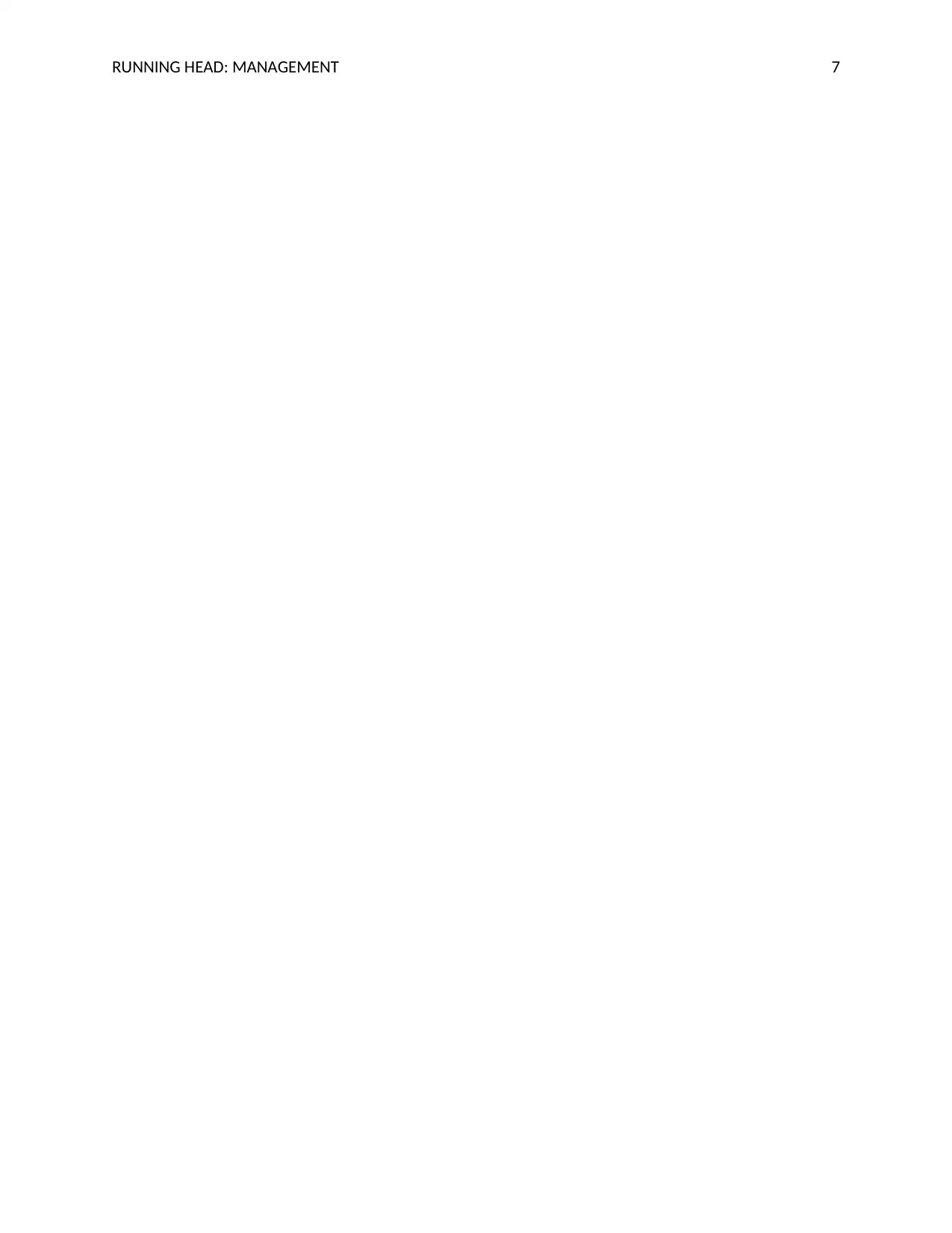
RUNNING HEAD: MANAGEMENT 7
1 out of 7
Related Documents
Your All-in-One AI-Powered Toolkit for Academic Success.
+13062052269
info@desklib.com
Available 24*7 on WhatsApp / Email
![[object Object]](/_next/static/media/star-bottom.7253800d.svg)
Unlock your academic potential
© 2024 | Zucol Services PVT LTD | All rights reserved.





